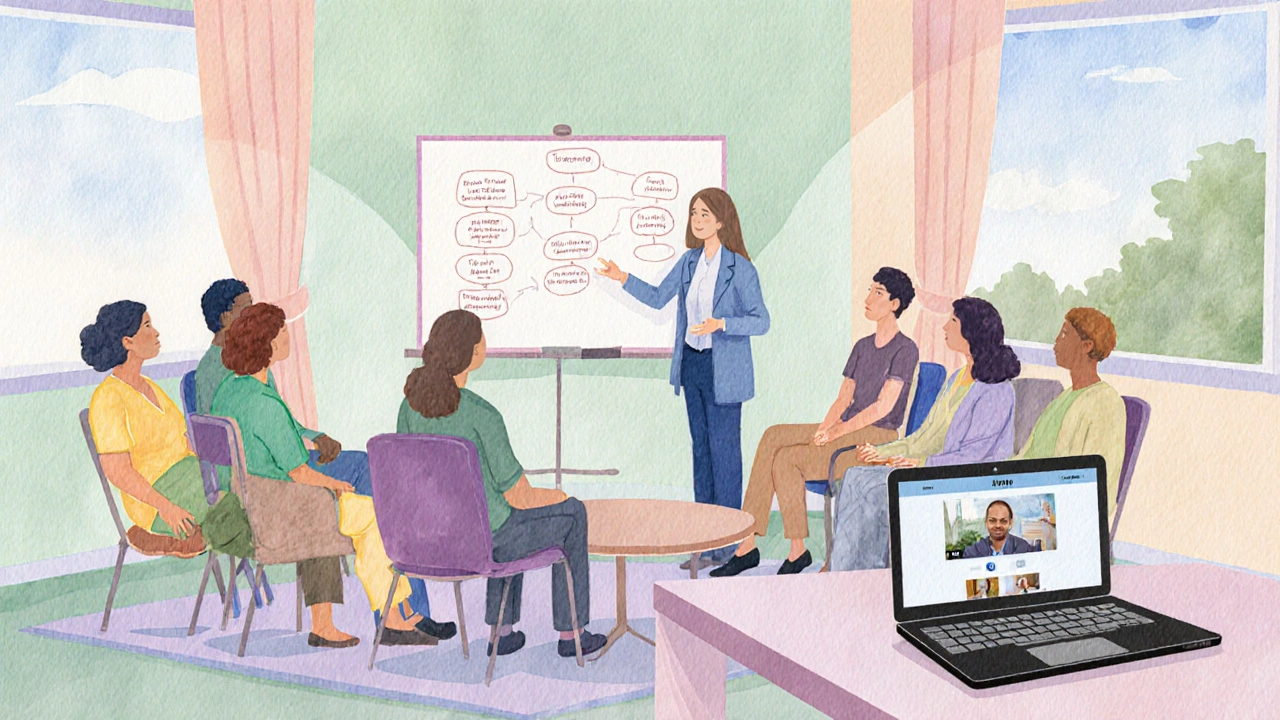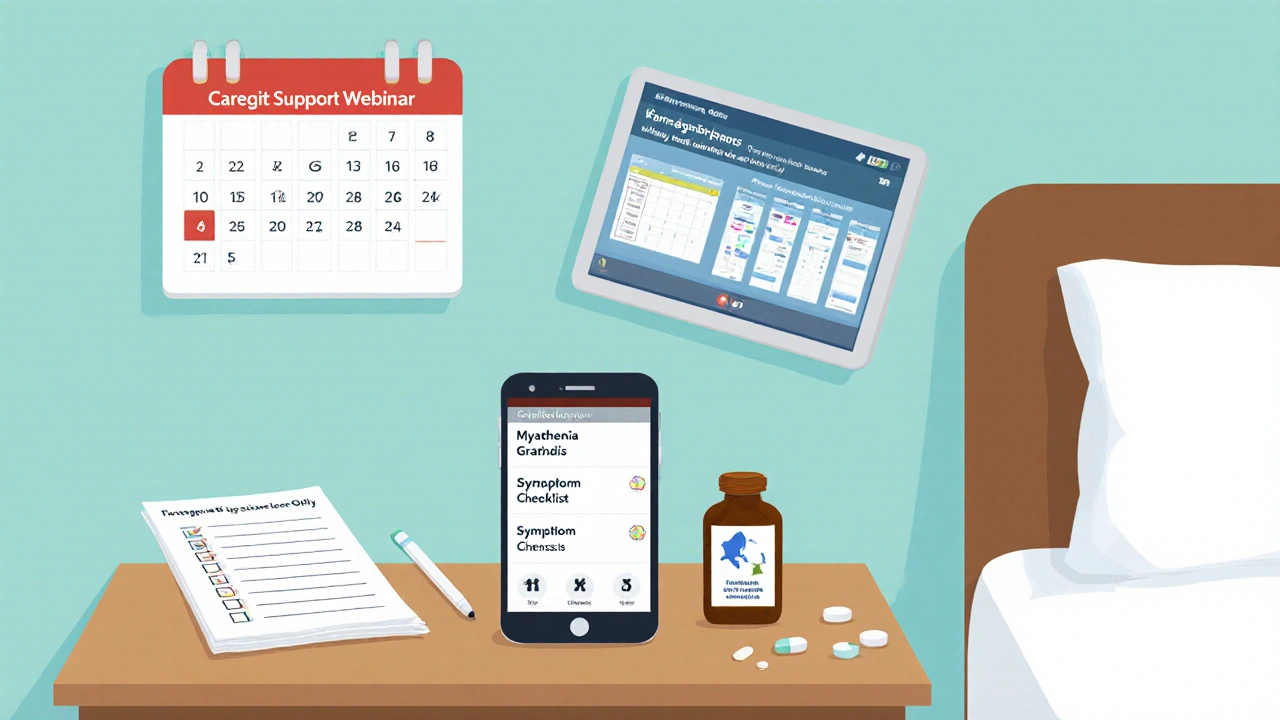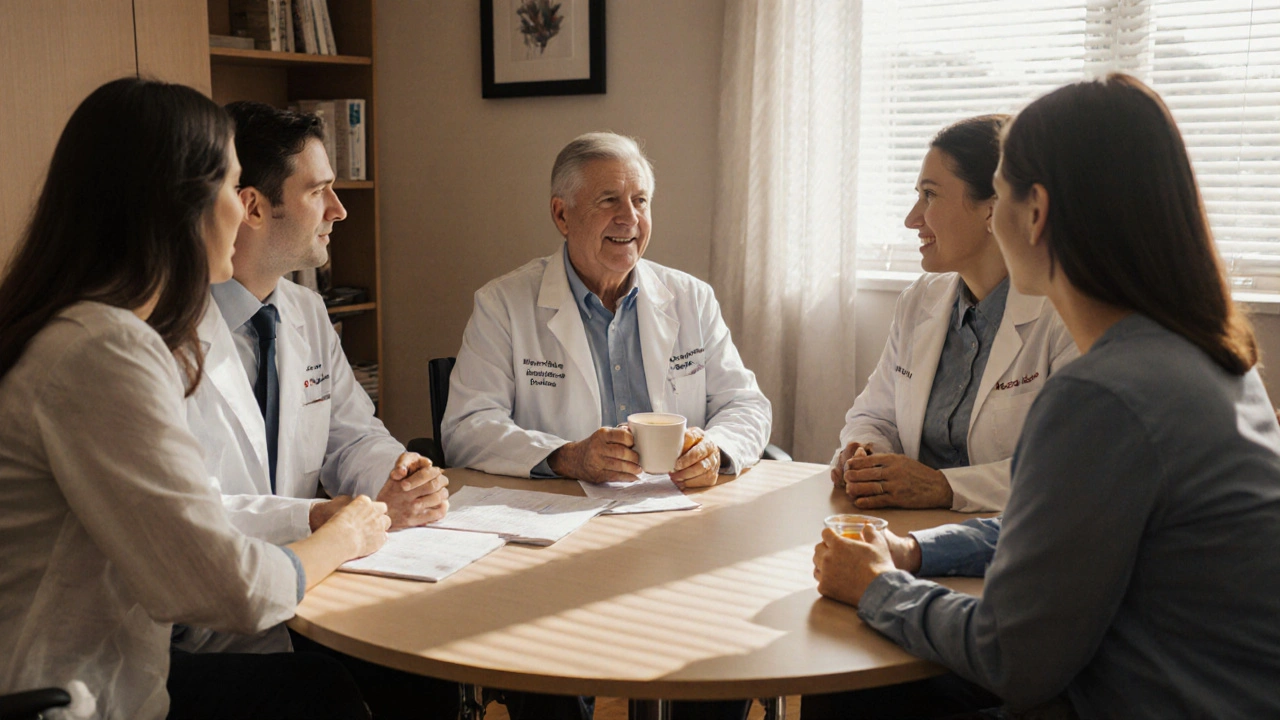Myasthenia Gravis Support System Assessment Tool
Assess Your Support System
Complete this assessment to identify gaps in your support network and receive personalized recommendations.
Creating a solid Myasthenia Gravis support system can dramatically improve quality of life, reduce hospital visits, and give patients a sense of belonging. Whether you’re a newly diagnosed patient, a family member, or a health professional, knowing the right steps to assemble a network of care saves time and anxiety.
Why Myasthenia Gravis Needs a Dedicated Support System
When dealing with Myasthenia Gravis is a chronic autoimmune neuromuscular disorder that causes fluctuating muscle weakness, patients often confront unpredictable fatigue, medication side‑effects, and social stigma. The disease’s rarity-affecting roughly 20 per 100,000 people-means many local doctors have limited experience, leaving patients feeling isolated. A well‑structured support system bridges that gap by linking medical expertise, peer encouragement, and practical resources.
Core Components of a Myasthenia Gravis Support System
A comprehensive system usually includes four pillars:
- Medical team - neurologist, immunologist, and primary care physicians who coordinate treatment.
- Peer network - support groups, both online and in‑person.
- Caregiver resources - education, respite services, and mental‑health counseling.
- Digital tools - symptom trackers, medication reminders, and reputable information portals.
Each pillar interacts with the others. For example, a neurologist may recommend a specific support group that focuses on patients undergoing Thymectomy - a surgical option that can improve outcomes for many.

Setting Up Peer Support Groups
Peer interaction combats the loneliness that often accompanies Autoimmune disease diagnoses. Here’s a step‑by‑step guide to launch a group that works:
- Identify the audience. Decide whether the group will serve newly diagnosed patients, long‑term survivors, caregivers, or a mix.
- Choose a format. In‑person meetings at community centers work well for local patients, while platforms like Facebook Groups, Slack, or dedicated forums serve a wider audience.
- Partner with a healthcare provider. Invite a Neurologist to give occasional talks about disease progression, medication adjustments, and emerging research.
- Set a regular schedule. Consistency encourages attendance. Monthly meetings are a common sweet spot.
- Create a safe space. Establish ground rules: confidentiality, respectful language, and a focus on sharing practical tips rather than medical advice.
- Promote the group. Use local clinics, hospital bulletin boards, and patient‑advocacy websites such as the Myasthenia Gravis Foundation of America.
When the group launches, track attendance, collect feedback, and adjust topics based on members’ needs. Typical discussion themes include managing medication timing, dealing with speech‑related fatigue, and navigating work accommodations.
Leveraging the Professional Healthcare Team
Even the best peer network cannot replace specialist care. The goal is to make the medical team a seamless part of the support system.
- Neurologist coordination. Ensure the neurologist documents a clear treatment plan that mentions dosage of Pyridostigmine, any immunosuppressants, and the schedule for antibody testing.
- Acetylcholine receptor antibodies monitoring. Regular blood tests (every 6-12 months) help gauge disease activity and guide medication tweaks.
- Physical therapy involvement. A licensed Physical therapist can design low‑impact exercises that maintain muscle strength without triggering fatigue.
- Integrated mental health. Psychologists or counselors familiar with chronic illness can address anxiety, depression, and coping strategies.
Ask the neurologist to provide a written summary of the care plan that can be shared with caregivers and support‑group leaders. This ensures everybody works from the same playbook.
Digital Tools & Resources
Technology makes coordination easier, especially for patients who travel infrequently to appointments. Below is a comparison of three popular digital options.
| Tool | Key Features | Cost | Best For |
|---|---|---|---|
| Myasthenia Gravis App (iOS/Android) | Medication reminders, symptom diary, antibody level tracker | Free basic, $4.99 premium | Patients who want a single‑purpose tracker |
| Patient portal (e.g., MyChart) | Secure messaging with doctors, lab results, appointment scheduling | Free (hospital‑provided) | Those already enrolled in a health system |
| Online forum (e.g., Reddit r/MyastheniaGravis) | Anonymous peer discussion, Q&A, resource links | Free | Anyone seeking community knowledge |
Pick one tool for daily use and another for occasional deep‑dives. Sync the app’s medication log with the doctor’s portal to keep the care team in the loop.

Support for Caregivers
Caregivers often juggle work, household duties, and the emotional load of watching a loved one cope with fluctuating weakness. Providing them with resources is a vital piece of the puzzle.
- Education sessions. Arrange quarterly webinars led by a Caregiver specialist that cover topics like safe lifting techniques and recognizing myasthenic crisis signs.
- Respite services. Local home‑health agencies may offer short‑term relief; some insurance plans cover a limited number of hours per year.
- Mental‑health check‑ins. Encourage caregivers to schedule an annual appointment with a therapist experienced in chronic‑illness burnout.
Creating a printable checklist for caregivers-available both in the support group packet and on the digital portal-helps them stay organized and reduces missed appointments.
Action Checklist: Building Your Support System
- Write down your primary medical contacts (neurologist, primary care, physical therapist).
- Identify at least two peer‑support venues (one online, one local).
- Choose a digital tool and set up daily medication reminders.
- Schedule a quarterly meeting with a caregiver‑support professional.
- Link your medication list to the patient portal for seamless sharing.
- Review antibody test results every 6-12 months and discuss changes with your neurologist.
Cross‑checking this list every month keeps the system dynamic and prevents gaps in care.
Frequently Asked Questions
How often should I meet with my support group?
Most patients find a monthly meeting works well. If you have a busy schedule, every six weeks is fine as long as the group stays consistent.
Can I rely solely on an online forum for medical advice?
No. Online forums are great for emotional support and practical tips, but any changes to medication or treatment must be approved by your neurologist.
What is the role of thymectomy in my treatment plan?
Thymectomy-removal of the thymus gland-can reduce antibody production in many patients, leading to lower medication doses and improved strength. Eligibility is evaluated by a thoracic surgeon in coordination with your neurologist.
How can I help my caregiver avoid burnout?
Encourage regular breaks, arrange respite care, and suggest they join a caregiver‑specific support group. Open communication about fatigue levels also lets you adjust responsibilities when needed.
Is there a recommended diet for Myasthenia Gravis?
A balanced diet rich in protein supports muscle repair, but avoid large, heavy meals that can worsen weakness after eating. Consult a dietitian familiar with neuromuscular disorders for personalized guidance.

Robert Ortega
October 12, 2025 AT 18:22Building a support network for Myasthenia Gravis is a team sport. You need the neurologist on board, a peer group that actually meets, and a couple of digital tools that keep meds and symptoms in sync. I’ve seen patients who start with a simple medication tracker and end up adding a caregiver checklist, and the difference is huge. The key is to keep checking the gaps every few months – sometimes a new therapist or an online forum can fill a missing piece.
Elizabeth Nisbet
October 17, 2025 AT 02:50Hey there, if you’re just getting started, try signing up for the Myasthenia Gravis Foundation’s local support group first. They usually have a monthly meeting, and a quick intro call with a physical therapist can give you a safe exercise plan right away. Also, set up the free Myasthenia Gravis App on your phone – those reminders save a lot of headaches.
Sydney Tammarine
October 21, 2025 AT 11:19Oh, look at the checklist – as if we needed another spreadsheet to remind us we’re sick. 🙄 Still, if you love ticking boxes, go ahead and fill them all, just don’t forget to breathe.
Geneva Angeles
October 25, 2025 AT 19:47When I first heard about building a support system for Myasthenia Gravis, I thought it would be a simple list of doctors and a few online forums, but the reality is far richer and more nuanced. The medical team, starting with a neurologist who truly understands the fluctuating nature of the disease, lays the groundwork for a treatment plan that can adapt over time, and that adaptability is crucial when symptoms can change from day to day. Adding an immunologist into the mix brings a deeper insight into how immune-modulating therapies can be fine‑tuned, especially when you consider the variety of antibodies that can be present. Your primary care physician, often the unsung hero, coordinates routine labs and keeps an eye on comorbidities that might otherwise slip under the radar. The physical therapist contributes low‑impact exercises that preserve muscle strength without triggering fatigue, a balance that’s often overlooked in standard care. Mental health professionals, whether psychologists or counselors, provide coping strategies that address the anxiety and depression that accompany a chronic illness, and this emotional scaffolding can be just as vital as medication. \\nBeyond the clinical team, peer networks offer a sense of belonging that no doctor can replicate; sharing personal stories in an online forum like r/MyastheniaGravis or meeting in‑person at a support group can reduce the feeling of isolation that many patients report. Caregiver resources, such as educational webinars and respite care services, not only lighten the load for families but also empower caregivers to recognize early signs of a myasthenic crisis. Digital tools, from symptom diaries to medication reminder apps, act as the glue that binds all these components, ensuring that information flows seamlessly between patient, provider, and support community. \nEvery pillar of this system interacts with the others – for example, a neurologist may recommend a specific support group that focuses on patients undergoing thymectomy, creating a tailored peer environment that addresses unique post‑surgical concerns. \nIn practice, the most successful systems are those that are regularly revisited; scheduling a quarterly review of your support network can highlight emerging gaps before they become problematic. \nDon’t underestimate the power of a simple checklist: write down your medical contacts, list at least two peer‑support venues, choose one digital tool for daily medication reminders, and arrange a quarterly meeting with a caregiver‑support specialist. \nWhen you keep this checklist visible – on your fridge, in a phone note, or on a wall in your living space – you turn abstract concepts into actionable steps. \nFinally, remember that building this system is a dynamic process; as treatments evolve and personal circumstances change, so too should your network. Embrace the flexibility, stay proactive, and you’ll find that managing Myasthenia Gravis becomes more about living well than merely surviving.
Scott Shubitz
October 30, 2025 AT 04:15Alright, let’s cut through the fluff. If you’re not already glued to a neurologist’s calendar, schedule one now – no excuses. Then, dump that generic "online forum" suggestion and join the official Myasthenia Gravis Foundation group; they actually have vetted resources. Your medication tracker is only useful if you log every dose, not just the days you remember. And stop pretending you don’t need a caregiver checklist – it’s the difference between a crisis and a calm evening.
Soumen Bhowmic
November 3, 2025 AT 12:43I totally agree with the previous point about the neurologist; it’s the cornerstone. In addition, I’d recommend setting up a shared Google Doc with your caregiver where you both can update medication changes, symptom notes, and upcoming appointments. This collaborative approach ensures no one falls through the cracks, especially when fatigue spikes and you forget to relay information. Also, don’t underestimate the value of a weekly check‑in call with your physical therapist – even a 15‑minute video session can keep your exercise regimen on track without exhausting you. Finally, consider adding a simple mood‑tracking app; mental health fluctuations often mirror physical symptoms, and catching that early can guide medication tweaks.
Jenna Michel
November 7, 2025 AT 21:11Great suggestions! Just a heads‑up: when you set up that shared doc, use the "comment" feature to flag urgent changes – it triggers a notification for the caregiver. Also, the Myasthenia Gravis App now supports push alerts for lab test reminders, so you won’t miss those antibody level checks. Lastly, try a short mindfulness routine each morning; it’s low‑effort but helps stabilize both mood and muscle fatigue.
Abby Richards
November 12, 2025 AT 05:40👍 Nice rundown! Adding emojis can make those reminder notes less intimidating. 😊
Lauren Taylor
November 16, 2025 AT 14:08From a mentorship perspective, it’s essential to embed terminology that patients can actually grasp. When you talk about "antibody titers," also explain that this is simply a blood test measuring the immune system’s activity against the acetylcholine receptor. Using layman’s analogies, like comparing the immune response to a thermostat, can demystify complex treatment plans and empower patients to engage more actively with their care team.
Timothy Javins
November 20, 2025 AT 22:36Honestly, I think most of these checklists are overkill. A simple list of doctor contacts and a reminder to drink water does the job just fine.
Sadie Viner
November 25, 2025 AT 07:04For anyone looking for a concise, evidence‑based roadmap, consider the following: 1) Verify that your neurologist has documented your medication dosages and side‑effect profile; 2) Ensure you have a registered patient portal account for secure messaging; 3) Join at least one peer‑support platform, preferably with moderated content; 4) Schedule quarterly caregiver education webinars; and 5) Use a validated symptom diary to track fluctuations. Following this protocol aligns with best practice guidelines and reduces unnecessary hospitalizations.
Kristen Moss
November 29, 2025 AT 15:33Gotta say, the US has some of the best Myasthenia Gravis resources out there – top‑notch specialists, cutting‑edge research, and a massive patient community. If you’re not tapping into American support groups, you’re missing out big time.
Michael Wall
December 4, 2025 AT 00:01It’s morally imperative that we prioritize ethical care above all else. Patients deserve transparent communication and should never be left to navigate these complexities alone.